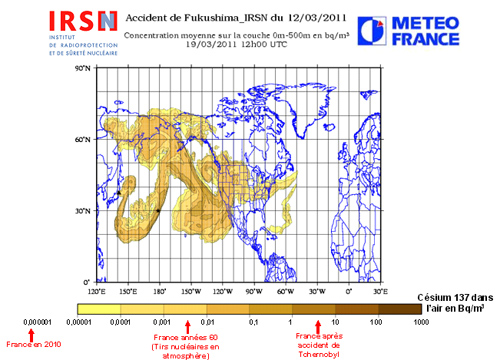Today, the French ISRN released some results of its computation of the Fukushima plume over Tokyo. Another simulation shows the plume till March 25th for the whole Globe taking into consideration data from the French meteorological office.
2 - The dispersion of radioactive releases into the atmosphere
IRSN simulated atmospheric dispersion of releases estimated between 12 and 22 March, using its numerical model applicable to long distance (scale of several hundred kilometers), using observations and weather forecasts provided by Weather France.
This simulation was applied to the cesium 137, as a tracer of the plume during this period. The modeling results are expressed in becquerels of cesium-137 per cubic meter of air (Bq / m 3).
Watch the simulation of the plume
This modeling performed throughout Japan shows that the plume has led in directions that have varied over time: first north-east until March 14, then south and southeast west toward Tokyo, March 15, then east toward the Pacific Ocean.
IRSN compared the simulation results with the results of measurements of air contamination carried in Tokyo. They are the same order of magnitude as the values measured in this city, as shown in the charts below for iodine 131 and cesium 137.
This comparison allows us to consider that the air dispersion modeling performed by IRSN to produce satisfactory results for the agglomeration of Tokyo and the doses calculated by IRSN from this modeling are representative of the doses may have been received by the population exposed to the radioactive plume.
and then for the whole globe:
4 - Modeling the dispersion of radioactive releases into the atmosphere on a global scale
From the estimated releases from IRSN, Meteo France has simulated the dispersion of radioactive releases from great distances, projected until March 26.
Watch the simulation
According to this simulation, the plume would now reached the north-eastern Siberia, the United States and western Atlantic. It should reach France from 23 or 24 March.
Merger expected to run from this model could be of the order of 0,001 Bq / m 3 in France and the overseas departments of the northern hemisphere. As expected, the southern hemisphere is not significantly affected by this large-scale dispersal.
For comparison, values measured in the days following the Chernobyl accident had exceeded 100 000 Bq / m 3 in the first few kilometers around the plant and they were in the range of 100 to 1000 Bq / m 3 in the country most affected by the plume (Ukraine, Belarus); France, values measured in the east were the order of 1 to 10 Bq/m3 (May 1, 1986). Today, a very low activity of cesium-137 remains in the air, on the order of 0.000001 Bq/m3.
To give some perspective, as per wikipedia, one Bq is defined as the activity of a quantity of radioactive material in which one nucleus decays per second.. From the TORCH report on how to computer the dose due to Cesium from its Bequerel units::
To sum these properties up
- The dose rate due to external irradiation from uniform contamination of the ground by 137Cs is 1.6 x 10-12 Sv hr-1 Bq-1 m2.
- The internal dose for ingestion is 1.2 x 10-8 Sv Bq-1
- The internal dose for inhalation is 8.7 x 10-9 Sv Bq-1
The maximum for this global computation is 1000 Bq/m^3. All other colors are decreasing by increment of ten from that maximum. This number has then to be multiplied by the low numbers above to obtain a dose. As can be seen from the US EPA detectors, this dose is part of the background radiation level. Another map of interest shows that the plume modeling is different for different research teams. The folks at Texas A&M provide computations showing particles in the plume flying at 2 to 4 km altitude while the french model is restricted to 500m high.




No comments:
Post a Comment